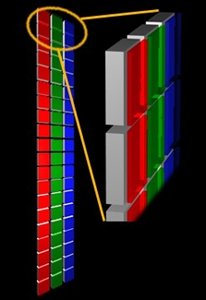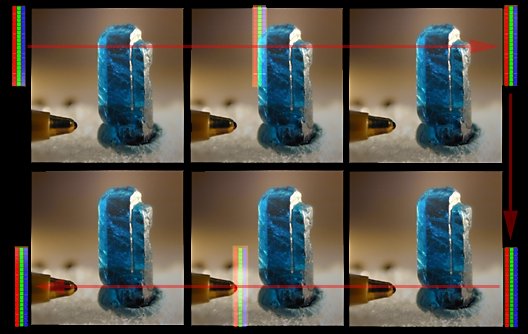
|
|
||||
|
Digital Photography -
Scanning |
||||
|
Scanners share some similarities with digital cameras, but the way they function is very different. Scanners use a ccd device to capture the image, but not a full array. Scanners use a linear array that has only three columns of cells. Each column of the array is sensitive to one of the three colors, Red, Green and Blue. The array is used to image the photography by scanning small areas of the original, and building up the entire picture in small segments. |
||||
 |
The diagram to the left illustrates the general schematic for a linear array used in a scanner. The photosensitive cells a grouped in three columns and each is fitted with a color sensitive material. Each column collects the information for one of the primary colors, and then each grouping is combined to create a single pixel with the resultant color. This type of ccd is far less expensive than the cells used in cameras because they have far fewer total pixels. The manufacturing process produces far fewer defective units and hence a better yield in overall production. The array is placed on a circuit board, which in turn is placed on a transport system. This module is used to capture an photograph in segments, and combine the results forming a single image. |
|||
|
||||
 |
||||
|
Typically a stepping motor is used to move the capture assembly from one end of the photograph to the other. A focusing mechanism is used to bring the image into focus on the capture array. The diagram above shows two passes using the cell, but in reality there is normally only one pass. A different mechanism is used to focus the width of the image before the array-light module is stepped again. The diagram just shows the concept that the entire image can be reproduced by moving the array over the entire surface. The arrays are far longer with more cells than the one diagramed. Scanners have two numerical values for resolution. One is based on the movement distance along the photograph and the number of times the array is used to capture information. The other is based on the pixel density of the array, and how it is used to capture the data in the perpendicular direction to the movement. Because of this scanners may be more accurate in one direction than the other. Scanner software provides controls to set the capture resolution based on Dot Per Inch (DPI), and it can be varied as the user desires. There are several parameters that differentiate one model scanner from another, but basically there are two important ones. |
||||